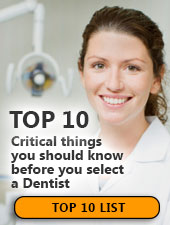Gingivitis and Gum Disease Basics
It afflicts as many as nine in ten adults at some point in their lives, as well as teenagers and children as young as five or six years of age. Yet, many suffer from it without even suspecting anything is wrong.
"It" is periodontal disease, or gingivitis - in the minds of most dentists, Public Enemy Number one for teeth.
Only for the last 30 years have researchers understood that gum disease is an infectious disorder, caused by many different species of bacteria. But even today, there is no cure. Fortunately, we have learned a good deal about what periodontal disease is and what can be done about it.
Behind the scenes
The culprits in gum disease are the bacteria that thrive in the crevices between gums and teeth, accumulating in the form of plaque, a hard, colorless film. Plaque produces toxins that not only irritate gums and cause bad breath, but can eventually attack connective tissue, bone and teeth.
These crevices become "pockets" where the bacteria lodge and begin to erode the tissues that connect gums with teeth. If periodontal disease isn't checked, the pockets deepen. The havoc spreads. Eventually, the bone around the teeth and roots is destroyed - and the teeth soon follow.
Sounding the alarm
How can you tell if you have a periodontal problem?
If you have bleeding gums or if you have swollen gums, gingivitis may be the reason why. But mouth disease can strike silently, without any pain or obvious signs.
Any bleeding from your gums should be a tip-off. Make sure you're doing a thorough but gentle job of brushing and flossing every day. If bleeding persists, it's time to see your periodontist. Different people have different levels of susceptibility to periodontal disease, and some forms - including those that affect children and adolescents - can develop quite rapidly.
Not everyone who has gingivitis disease goes on to develop more serious periodontal problems. Some people manage to reverse the disease or stop the progress of chronic gingivitis when it flares up.
Until there's a cure, the fundamentals of gum disease prevention - regular professional care and careful brushing and flossing at home - are still the best line of offense for good dental health.
Ways to fight back
- Periodontal disease can be checked and often reversed with simple preventive measures: brushing, flossing and professional cleaning to remove plaque and stimulate gum circulation.
- If the problem has become more serious, the dentist may do what's called scaling and planing - deep scraping of plaque from under the gum line, and smoothing of root and tooth surfaces so gum tissues have a better chance to reattach.
- Promising new gum disease treatment is already on the horizon: antiseptic or antibiotic drugs placed at the site of infection. And new chlorhexidine mouthwashes that may help prevent the formation of plaque.
«« Back to Dental Information Center
Don't Forget to Floss!
Clean between teeth daily with floss or an interdental cleaner. Decay-causing bacteria can hide between teeth where toothbrush bristles can't reach. Flossing helps remove plaque and food particles from between teeth and under the gum line.
Visit Our Office Regularly!
Take good care of your smile. Remember to visit the dentist regularly for professional cleanings and oral exams.
Mouthwash Is Important, Too!
Brushing and flossing may not be enough. The ADA now recommends using an antimicrobial mouthwash to reduce plaque and prevent gingivitis.





